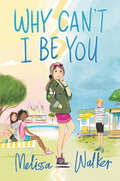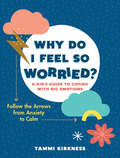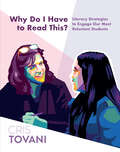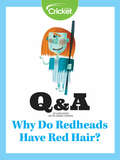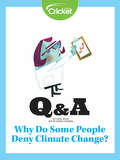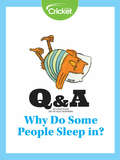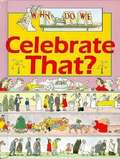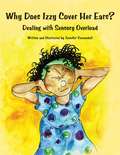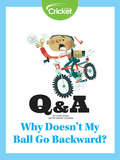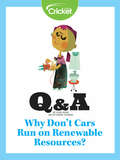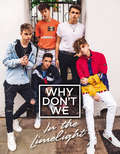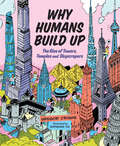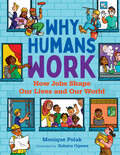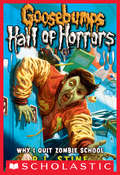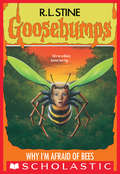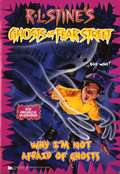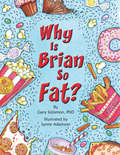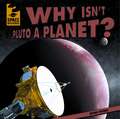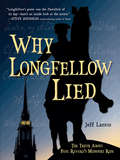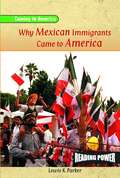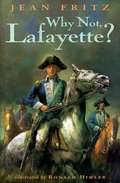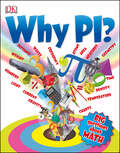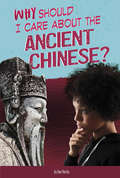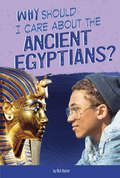- Table View
- List View
Why Can't I Be You
by Melissa Walker“This book is for anyone who has ever felt ‘less than’ or on the outside. That is to say, this is a book for everyone.” —Elana K. Arnold, author of What Girls Are Made Of"With a clear, compelling voice, Walker creates a believable world where socioeconomic tensions challenge, but never defeat, her well-rounded characters."—Publishers Weekly (starred review)Claire Ladd knows that this summer is going to be special. She and her two best friends, Ronan and Brianna, are turning twelve. She is leaving camp behind and gets to do what she wants all day. She feels everything starting to change. But things don’t always change for the better.With Brianna’s cousin Eden visiting for the summer, Claire feels like a third wheel. Even though she is only a year older, Eden seems so much more sophisticated and glamorous . . . and when she's around, she takes up everyone’s attention, including Brianna’s.But that doesn’t explain why things have felt awkward with Brianna ever since she moved to a fancy new house, or why Ronan, who lives in the trailer next to Claire’s, has started acting moody anytime anyone mentions his dad.Claire has always been happy with her life just as it is, but as the summer wears on and the issues with her friends start to grow, she can’t help but wonder: Would everything be better if she could just be someone else?
Why Do I Feel So Worried?: A Kid's Guide to Coping with Big Emotions—Follow the Arrows from Anxiety to Calm
by Tammi KirknessSimple yes-or-no questions help kids ages 7 to 12 find the right calming activities for every kind of anxiety It can be tough for kids with growing minds to work through their worries and self-soothe when they&’re spiraling. This interactive, step-by-step guide is here to help! In Why Do I Feel So Worried?, children can follow an easy-to-use, colorfully illustrated flowchart to . . . Name the emotion they&’re struggling with (like stress)Figure out its source (for instance, homework problems)Calm down with an easy activity (such as a soothing script) Every tried-and-tested strategy—from breathing techniques to meditations, affirmations, and more—offers in-the-moment relief to anxious children. And throughout, notes to caregivers explain the underlying psychology along with how (and when) to offer help. Kids might not always be able to solve what&’s worrying them—but they do have the power to help themselves feel better!
Why Do I Have to Read This?: Literacy Strategies to Engage Our Most Reluctant Students
by Cris TovaniWhy do I have to read this?- What teacher doesn't dread this question? It usually comes from our most disengaged students a student who cries of boredom, or one who is angry or apathetic. When we don't know what else to try, it's easy to become frustrated and give up on these challenging learners. Author Cris Tovani has spent her career figuring out how to entice challenging students back into the process of learning. Why Do I Have to Read This?: Literacy Strategies to Engage our Most Reluctant Students Tovani shares her best secrets, lessons learned from big fails, and her most effective literacy and planning strategies that hook these hard to get learners. You will meet many of Tovani's students inside this book. As she describes some of her favorites, you may even recognize a few of your own. You will laugh at her stories and take comfort in her easily adaptable strategies that help students remove their masks of disengagement. She shows teachers how to plan by anticipating students' needs. HerC urriculumY ouA nticipate structures of Topic, Task, Targets, Text, Tend to me, and Time willhelp you anticipate your curriculum. InsideWhy Do I Have to Read This? readers will find: Literacy strategies for all content areas that support and engage a wide range of learners so they can read and write a variety of complex textReference charts packed with small bites of instructional shifts that coaches and teachers can use to quickly adjust instruction to re-engage studentsPlanning strategies that show teachers how to connect day-to-day instruction so that no day lives in isolationVersatile think sheets that are reproducible and adaptable to different grade levels, content areas, and disciplinesAbove all, Tovani gives teachers energy to get back into the classroom and face students who wear masks of disengagement. She reminds us of the importance of connecting students to compelling topics, rich text, useful targets, and worthy tasks. Teachers must tendto students' basic needs and helps us consider how to best structure instructional time.After reading this book, teachers will have new ways to connect with students in a deep, authentic way. Written in a humorous, compassionate, and wise voice,Why Do I Have to Read This? will provide answers to the pressing questions we have when we try to teach and reach all of our students.
Why Do Redheads Have Red Hair?
by Lizzie WadeIn this engrossing Q & A, you'll learn why some people have red hair. It's related to what type of genes you have.
Why Do Some People Deny Climate Change?
by Lizzie WadeDespite a mountain of evidence, some people still don't believe that climate change is occurring. Why is that? Find out in this insightful Q & A.
Why Do Some People Sleep in?
by Lizzie WadeWhy do some people sleep in longer than others? This Q & A explains the disparity of different people's need for sleep.
Why Do We Celebrate That?
by Jane WilcoxFind out why we celebrate being born, the coming of age, weddings, spring, summer, fall, winter, the New Year, farming festivals, fasts, feasts, pilgrimages, birthdays, holy people, dying, festivals, national holidays and take a quiz at the end of the book.
Why Does Izzy Cover Her Ears? Dealing With Sensory Overload
by Jennifer VeenendallAn illustrated book that creates an environment that is accepting of students with sensory modulation difficulties, including many on the autism spectrum. It includes definitions of sensory processing and sensory modulation disorder, suggested discussion questions, and lists of related books and websites.
Why Doesn't My Ball Go Backward?
by Lizzie WadeIf you throw a ball up while riding your bike, it does not go backward! Why is that?
Why Don't Cars Run on Renewable Resources?
by Lizzie WadeA bioengineer at Tel Aviv University in Israel explains how to extract renewable energy from a potato.
Why Don't We: In the Limelight
by Why Don'T WeIn the Limelight is the official Why Don’t We autobiography, full of never-before-seen photos and behind-the-scenes info about one of today’s hottest bands.When five guys decided to form a band, they never imagined that they would go from playing music online to playing tours across the world so quickly. Why Don’t We has been together for less than two years, and they’ve already headlined sold out shows, played at Madison Square Garden, and amassed millions of fans. And this is all just the beginning.This is the official Why Don’t We story, full of never-before-seen photos and everything you need to know about Corbyn, Daniel, Zach, Jonah, and Jack. Find out the secrets they’ve never shared with fans before, their embarrassing childhood stories, what they look for in a girlfriend, and how it felt to have their lives completely changed by this incredible journey.
Why Humans Build Up: The Rise of Towers, Temples and Skyscrapers (Orca Timeline #1)
by Gregor Craigie★“This great STEAM offering has multiple applications and will be useful for report writers and aspiring architects alike.”—Booklist, starred review ★“Finely detailed inside and outside...Broad in scope, perceptively organized, and enriched with fascinating entries.”—Kirkus Reviews, starred review Why did they build it so high? People have been constructing tall buildings for thousands of years, for many different reasons. Castle walls kept people safe. Utility towers transmit TV and cell-phone signals. Observatories give people a bird’s-eye view of the world. Beautiful buildings stand out in the crowd. Skyscrapers provide housing for a lot of people. There are some good reasons for building up, and a few bad ones as well. With a growing global population, we will need more and more space to live, learn and work in. But what does that mean for the health of the planet? Can we do it sustainably? Tall buildings may be part of the answer. From the Great Pyramids of Giza and the Leaning Tower of Pisa to the Burj Khalifa and the Shanghai Tower, Why Humans Build Up asks why and how we build higher and higher, and what that means for the planet.
Why Humans Work: How Jobs Shape Our Lives and Our World (Orca Think #6)
by Monique PolakWhat do you want to be when you grow up? I bet you've been asked that question before. But have you ever thought about why humans work? There are almost 3.5 billion people working in the world today, and that number is growing. In Why Do We Work? author Monique Polak investigates the past, present and future of jobs, including how work has also been shaped by discrimination, privilege and child labor. Meet a variety of working professionals and explore why we have careers, vocations and professions. How is the way we work changing, and what will it look like in the future?
Why I Quit Zombie School: Hall Of Horrors #4: Why I Quit Zombie School (Goosebumps Hall of Horrors #4)
by R. L. StineWelcome to the Hall of Horrors, HorrorLand's Hall of Fame for the truly terrifying.Poor Matt Krinsky! Not only are his parents making him move away from all of his friends, but they're enrolling him in a boarding school. It's not a strict place, but that doesn't mean things are normal. While Matt is used to be being one of the better athletes in his class, theses kids move a dead-slow pace. It's doesn't take long for him to realize that he's surrounded by zombies. And his classmates have begun to notice his heartbeat and warm skin. Can Matt convince them he is undead long enough to stay alive?
Why I'm Afraid of Bees (Goosebumps #17)
by R. L. StineGary Lutz needs a vacation . . . from himself. Bullies are constantly beating him up. His only friend is his computer. Even his little sister doesn't like him.But now Gary's dream is about to come true. He's going to exchange bodies with another kid for a whole week.Gary can't wait to get a new body. Until something horrible happens. And Gary finds out his new body isn't exactly human...
Why I'm Not Afraid of Ghosts (Ghosts of Fear Street #23)
by R. L. StineOliver Brown doesn’t believe in ghosts. Even though he lives in a house on Fear Street that’s chock full of them! Robbie should know—he’s one of the ghosts. And his new neighbor doesn’t scare easy—even though he’s tried everything he can think of to send Oliver screaming. Robbie’s got one trick left up his sleeve. And it has to work. If it doesn’t, he’ll have to give up the ghost business forever.
Why Is Brian So Fat?
by Lynne Adamson Ph.D. Gary SolomonA poignant story of Brian, a twelve-year-old boy who eats instead of feeling to avoid the reality of living with his dysfunctional family.
Why Isn't Pluto A Planet? (Space Mysteries Series)
by Michael PortmanFor many years, it was accepted as fact that our solar system had nine planets. <P><P>However, one important meeting of astronomers in 2006 reduced that number to eight. They decided that Pluto was not a planet, a declaration that outraged some people. <P><P>Readers will learn more about distant Pluto, such as how it was accidentally discovered. Brilliant photographs accompany the fascinating facts.
Why Longfellow Lied: The Truth About Paul Revere's Midnight Ride
by Jeff LantosPaul Revere's daring midnight ride made him an instant celebrity, right? Wrong! At first, no one in Boston even wanted to mention it. Jeff Lantos pulls apart Longfellow's famous poem "Paul Revere's Ride" to unravel how and why he twisted historical facts.Do you know how historically inaccurate "Paul Revere's Ride" is? And do you know why? Author Jeff Lantos pulls apart Longfellow's poem, tells the real story about Paul Revere's historic ride, and sets the record right. Not only that, he lays out when and why Longfellow wrote his poem and explains how without it, many of us wouldn't know much about Revere at all. This is Steve Sheinkin for the younger set, complete with an American mystery and a look at two important moments in the history of our country.
Why Mexican Immigrants Came to America (Coming to America Ser.)
by Lewis K. ParkerExplores the history of Mexican immigration to what is now the United States, and looks at the contributions of Mexican Americans to the culture of their new country.
Why Not, Lafayette?
by Jean FritzTraces the life of the French nobleman who fought for democracy in revolutions in both the United States and France.
Why Pi? (Big Questions)
by Johnny BallThis entertaining follow-up to DK's popular Go Figure!, Why Pi? presents even more mind-bending ways to think about numbers. This time, author Johnny Ball focuses on how people have used numbers to measure things through the ages, from the ways the ancient Egyptians measured the pyramids to how modern scientists measure time and space. Johnny Ball has hosted more than 20 UK children's television series about math and science. He is known for making math not just easy to understand, but genuinely fun and fascinating. His shows and videos earned him a New York international EMMY nomination, a BAFTA, and 10 other awards. He has written five children's books, including DK's Go Figure!, and an educational musical. His academic credentials include three honorary science doctorates and fellowship of the British Mathematical Association.
Why Should I Care About the Ancient Chinese? (Why Should I Care About History?)
by Claire ThropFrom pasta to paper, the inventions of the Ancient Chinese remain part of everyday life in our modern world. Learn how items like wheelbarrows, the first toothbrushes, and early earthquake detectors have evolved into devices we know today and discover just how big of an impact the Ancient Chinese have had on your life.
Why Should I Care About the Ancient Egyptians? (Why Should I Care About History?)
by Nick HunterThe Ancient Egyptians are famous for their pyramids and mummies, but how do these ancient items impact your life today? From hieroglyphs evolving into emojis and kohl around the eyes evolving into eye liner and mascara, the inventions and discoveries of Ancient Egypt offer us endless reasons to appreciate history.
